Description
(mention on Kerrang, pre-first LP!)

Label: Music For Nations – MFN 46
Format: Vinyl, LP, Album
Country: UK
Released: 1985
Genre: Thrash, Speed Metal
Tracklist
A1 Last Rites / Loved To Death 4:38
A2 Killing Is My Business… And Business Is Good! 3:02
A3 Skull Beneath The Skin 3:42
A4 These Boots 3:39 Songwriter [Song Written By] – Lee Hazlewood
B1 Rattlehead 3:39 Timpani – Gar Samuelson
B2 Chosen Ones 2:50
B3 Looking Down The Cross 4:58
B4 Mechanix 4:20
Phonographic Copyright (p) – Music For Nations
Licensed From – Combat
Published By – Take Out Music
Published By – Lorna Music
Bass Guitar, Backing Vocals – David Ellefson
Co-producer – Megadeth
Design [Album Design] – Donald J. Munz
Drums – Gar Samuelson
Lead Guitar – Chris Poland, Dave Mustaine
Producer – Dave Mustaine, Karat Faye
Producer [Pre Production] – Jay Jones
Songwriter [Song Written By] – Dave Mustaine (tracks: A1 to A3, B1 to B4), Megadeth (tracks: A1 to A3, B1 to B4)
Issued with a printed inner sleeve. No barcode on the back sleeve.
Recorded & mixed at Indigo Ranch Studios, Malibu and Crystal Sound Labs, Hollywood, December 1984 and January 1985.
Track A1 appear as “Last Rites / Love To Deth” on the center label and as “Last Rites / Loved To Death” on the back sleeve.
Track A4 is a cover version and appear as “Boots” on the center label and as “These Boots” on the back sleeve.
Album title appear as “Killing is my business… (And business is good)” on the center labels.
All songs published by Take Out Music except track A4 published by Lorna Music Co.
Back sleeve:
Issued under licence from Combat Records.
Music For Nations, 4th Floor, 8 Carnaby Street, London W1V 1PG
Center labels:
℗ 1985 Music For Nations
Made in France
Barcode and Other Identifiers
Barcode: none
Matrix / Runout (A-side etchings): MFN 46 A 1 MPO
Matrix / Runout (B-side etchings): MFN 46 B 1 MPO
MFN 46 + INNER WITH LYRICS
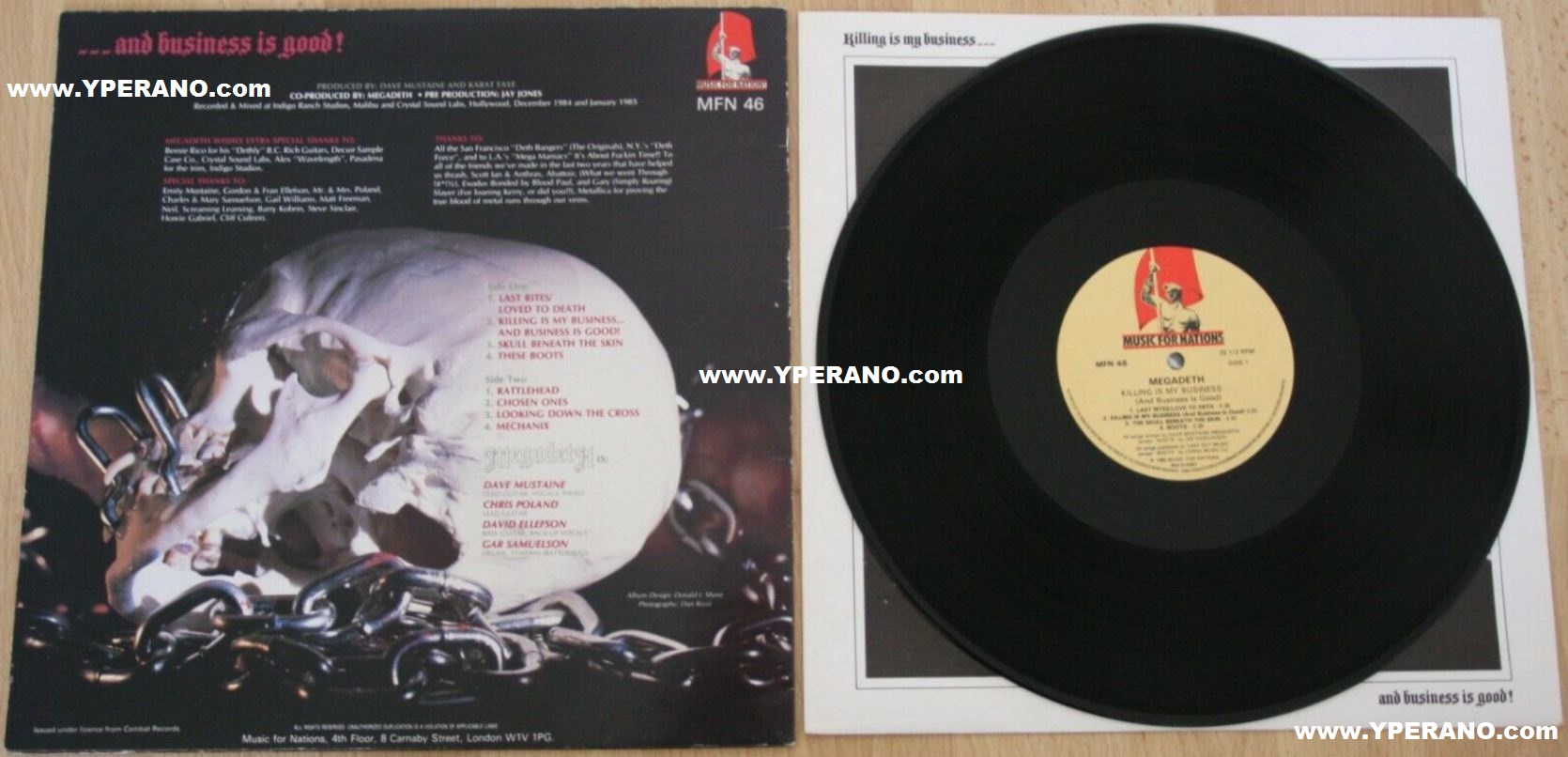
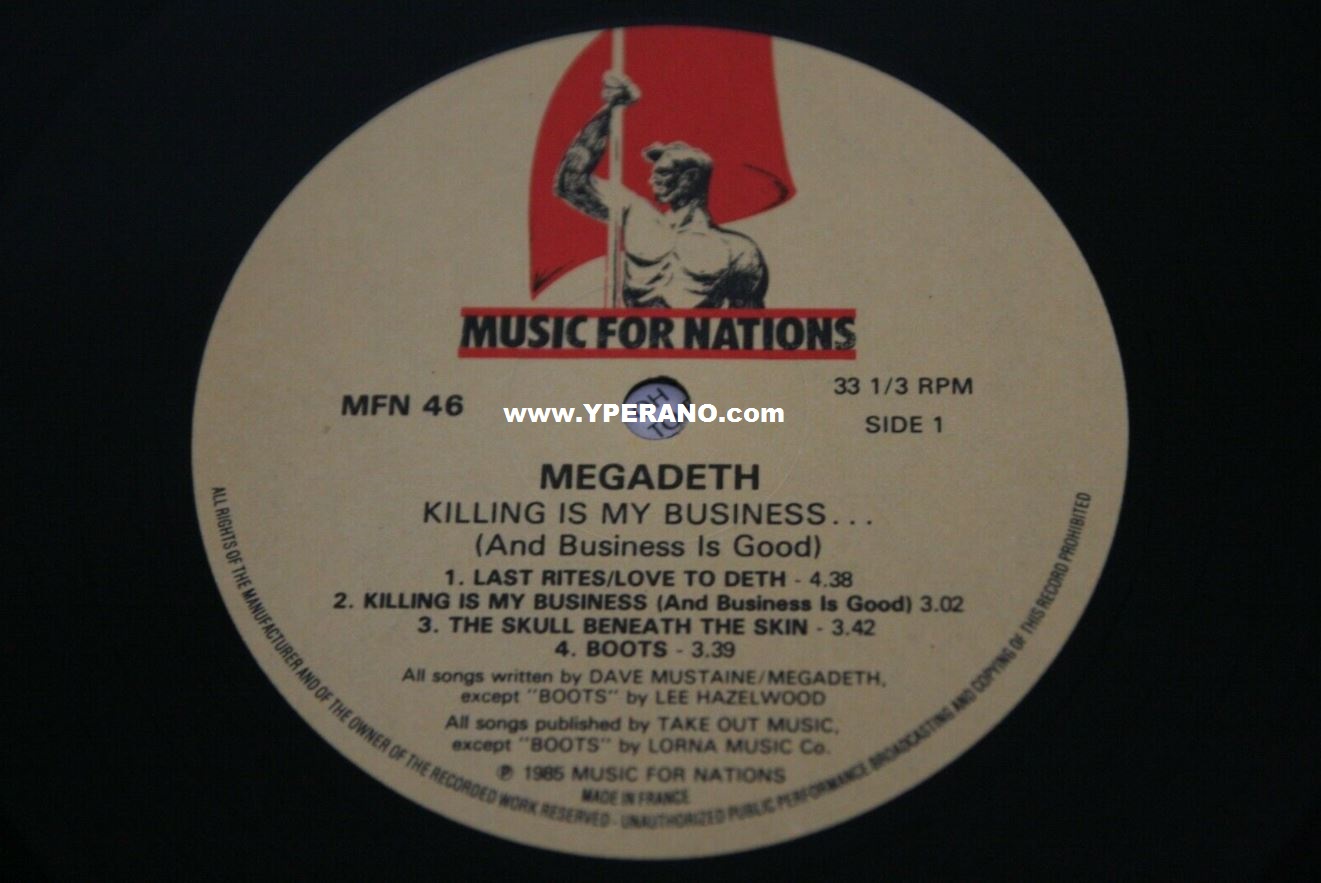
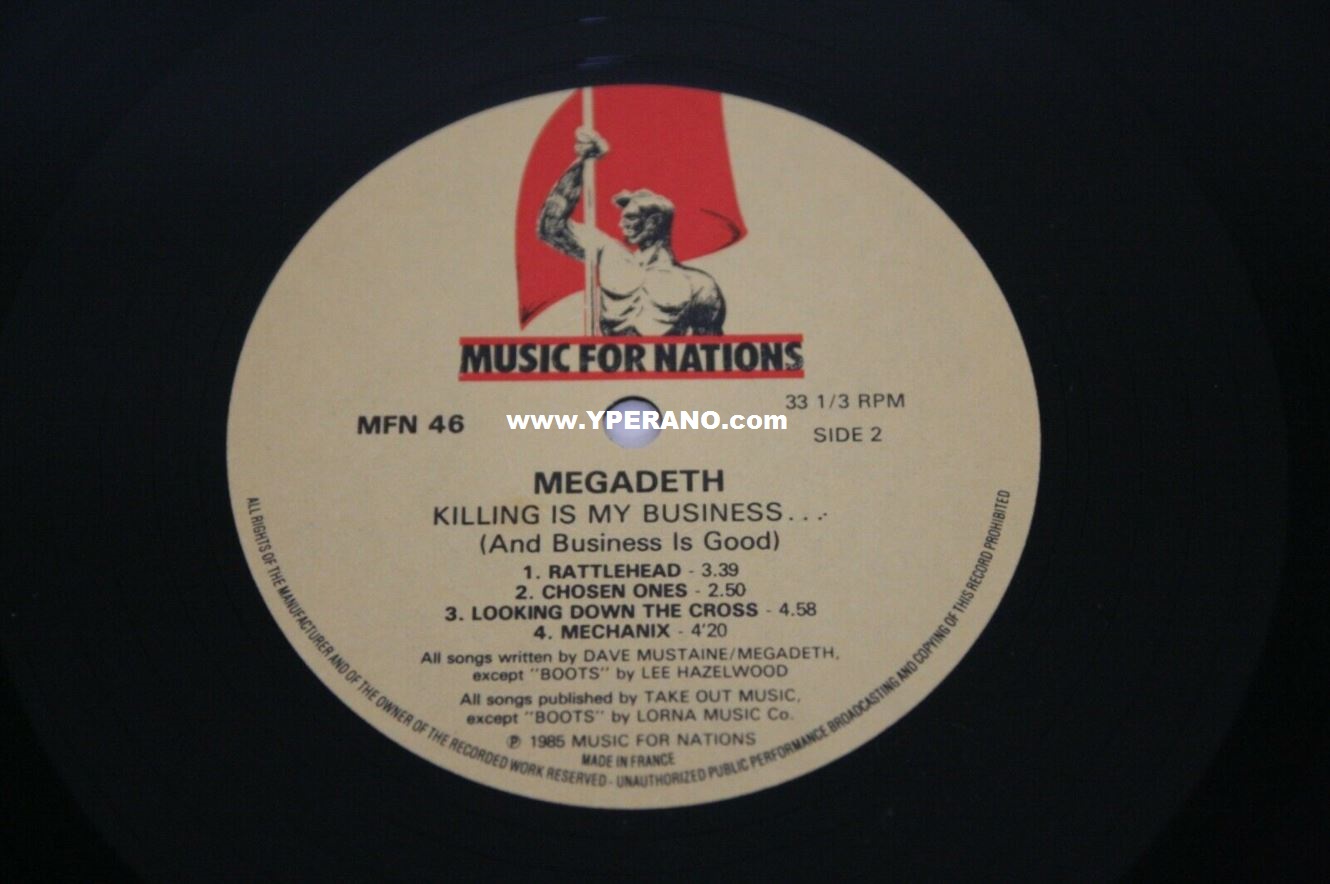
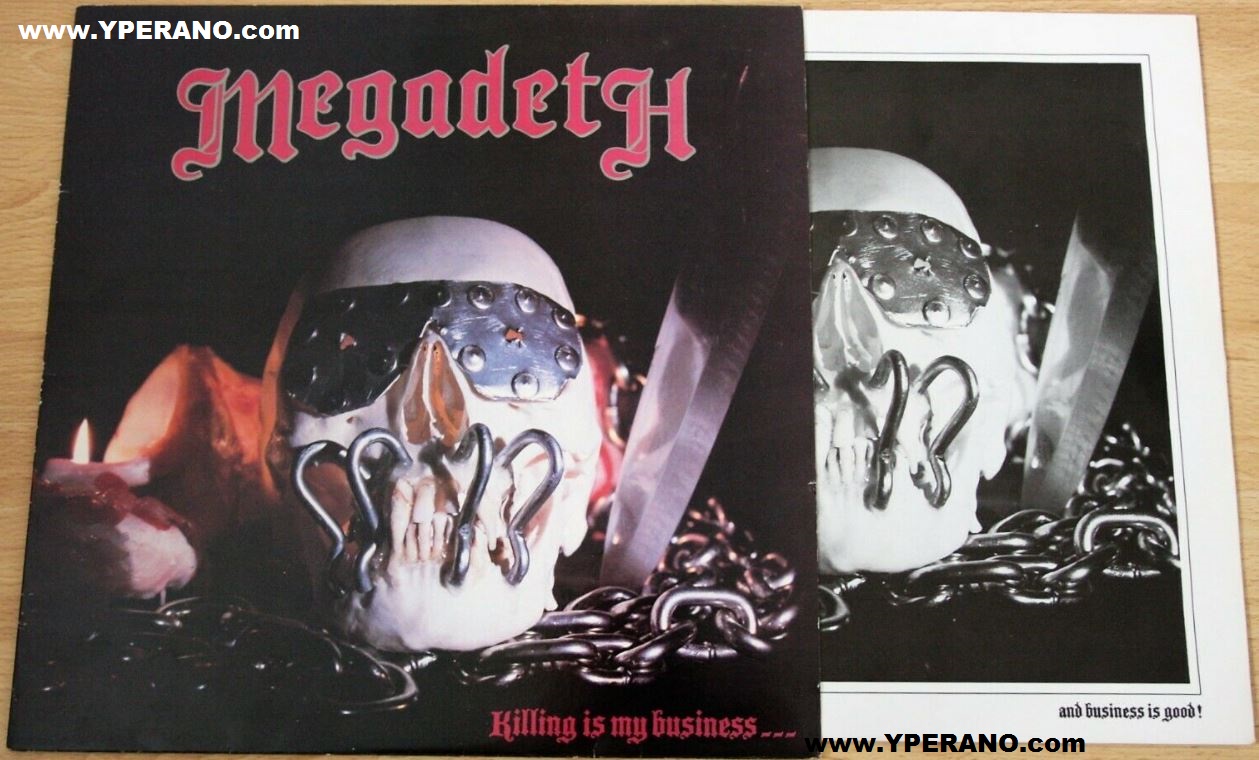


Early in 1985, the band was given $9,000 by Combat Records to record and produce their debut album. However, after spending half of the album budget on drugs, alcohol, and food the band was forced to fire their original producer and produce the album themselves. Killing Is My Business… and Business Is Good!, released in May 1985, was a well-received effort that blended elements of thrash, and speed metal.
The album features the first of many cover songs performed by Megadeth; a speed metal version of Nancy Sinatra classic “”These Boots Are Made for Walkin'””, with lyrics altered by Mustaine. The song sparked controversy in later years when the song original author, Lee Hazlewood, deemed Mustaine changes to be “”vile and offensive”” and demanded that the song be removed from the album.
In the summer of 1985, the group toured the United States and Canada for the first time, supporting Killing Is My Business… with Exciter. During the tour, new guitarist Chris Poland abruptly left the band.
Killing Is My Business… and Business Is Good! is the debut album by American heavy metal band Megadeth. It was originally released in 1985 on Combat Records. The album received positive reviews, even from mainstream music critics.
According to “”National Album Positioning Charts,”” Killing is My Business… and Business is Good! sold 189,230 albums worldwide.
The album artwork, featuring a plastic skull with tinfoil, was not intended to be the original artwork. Both guitarist/vocalist Dave Mustaine and bassist Dave Ellefson had many phones conversation with Combat records to get the cover artwork properly reproduced from a sketch given to them by Mustaine of a picture of Megadeth mascot Vic Rattlehead on the cover. However the studio lost the artwork, and instead made their own and improvised the low-budget replacement, which Mustaine and the whole band were mortified with.
When Killing Is My Business… And Business Is Good! was released, on 12 June 1985, heavy metal had changed – and Megadeth were playing a vital role in its transformation. Bands based on the West Coast of the US had taken the NWOBHM template of UK groups such as Iron Maiden, Diamond Head and Angel Witch, and added a new level of speed and aggression. Thrash metal was born.

The birth of Megadeth
Megadeth were formed by Dave Mustaine, former lead guitarist for Metallica. As the story goes, Mustaine’s ousting from that group occurred in April 1983, after the band had driven from Los Angeles to New York to record their debut album, Kill ’Em All. Faced with a three-day journey travelling back to LA on a Greyhound bus, Mustaine scribbled down ideas that eventually became Megadeth songs.
Losing his place in Metallica pulled Mustaine into sharp focus. He worked as a telemarketer for a brief period, to earn enough money to buy his own apartment, and though his next band, Fallen Angels, didn’t amount to anything, Mustaine continued to try out various musicians. By the end of 1984, he had formed a line-up of lead guitarist Chris Poland, bassist David Ellefson and drummer Gar Samuelson to form Megadeth.

Recording Killing Is My Business… And Business Is Good!
After gigging with various line-ups throughout 1984 – including a brief period with Slayer’s Kerry King on second guitar – Mustaine had a demo that he shopped around to several record labels. Securing an $8,000 deal with Combat Records, the group promptly spent half their budget on supplies, and the other half on a producer that they subsequently fired. With limited finances left, Mustaine took on the producer’s role himself at recording sessions held at Indigo Ranch in California.
From those sessions came Megadeth’s debut album, Killing Is My Business… And Business Is Good! Though the lack of a seasoned producer shows, that doesn’t take away from the ferocious speed, technicality and musicality contained in its songs. The album opens with ‘Last Rites’/‘Loved To Death’, a two-part track that starts with a rendition of a classical passage by JS Bach, before segueing into Mustaine’s ode to his then-girlfriend – probably the most blisteringly fast love song you’re ever likely to hear.
The album’s title track features a more groove-based beginning, before building into a high-tempo thrash crescendo. ‘The Skull Beneath’ has a lumbering rhythm leading into multiple tempo changes, and documents the birth of the band’s mascot, Vic Rattlehead – who is also the subject of the thrashtastic ‘Rattlehead’. ‘Chosen Ones’ and ‘Looking Down The Cross’ bring some structure to the thrash mix while continuing the overall themes of murder, dying and the occult. Despite these songs’ morbid lyrics, two other tracks are perhaps the album’s most controversial.

“Vile and offensive”
When Mustaine left Metallica, he insisted that they weren’t to use any of the music that he wrote with them. But it doesn’t take an expert to note the similarities between ‘Mechanix’ and his previous band’s ‘The Four Horsemen’, from Kill ’Em All. Metallica’s version was played at a slower pace and with a midtempo breakdown in the middle, showing a more mature songcraft. Not that Mustaine cared. In fact, the whole point of Megadeth was to prove that he could play faster and heavier than them.
Original versions of Killing Is My Business… feature a speed metal cover of ‘These Boots Were Made For Walking’, originally recorded by Nancy Sinatra. But the song’s writer, Lee Hazelwood, objected to what Megadeth had done to it, calling the cover “vile and offensive”. Megadeth reworked it for a 2002 reissue of the album with censored lyrics in the absence of Hazelwood’s permission to release it, while an uncensored version featuring the original lyrics emerged on a 2018 reissue.
The album may be raw and unpolished, but it’s testament to Megadeth’s competence that the speed and power of Killing Is My Business… And Business Is Good! punches through the mix. Its high-energy fury set the band on a path to becoming the hugely influential thrash legends they are today.
How Dave Mustaine Thrashed Metallica with Megadeth’s Debut
When Megadeth unleashed their first LP, Killing Is My Business … and Business Is Good!, on June 12, 1985, they were the last of thrash metal’s Big Four — the platinum-selling pace-setters, completed by Metallica, Slayer, and Anthrax — to debut.
However, unlike other late arrivals to the thrash-metal mosh pit, such as Exodus, Overkill, and Testament, Megadeth had a secret weapon in bandleader Dave Mustaine, whose early day involvement with, and acrimonious firing from, Metallica provided a level of experience and a burning ambition that was arguably eclipsed only by Mustaine’s abundant talents.
Having learned his lesson the hard way, Mustaine later admitted to Mick Wall in the latter’s Metallica biography, Enter Night, that, “Democracy doesn’t work in a band. I had to have my own band and make music exactly the way I wanted to hear it, with no compromises to anybody else’s ego, whatsoever.”
So, Mustaine spent the better part of 1984 searching diligently for the ideal cohorts who would both support and obey his personal vision for the ultimate thrash band, a painstaking process that saw him cycling through almost a dozen candidates before settling on bassist David Ellefson, drummer Gar Samuelson, and second guitarist Chris Poland.
All the while, Mustaine had been working on new songs, which, as Ellefson later explained to Wall, had to meet the very high expectations of those fortunate enough to have witnessed Mustaine playing with his now-famous former band: “The initial stuff we were writing was slow [but] all the fans up in the Bay Area kept writing letters saying, ‘Man, I hope your stuff is faster than Metallica!’”
Uh, no pressure, then!
But as the confident Mustaine boasted to Headbanger fanzine editor (and later Shockwaves Podcast producer) Bob Nalbandian at the time: “Truthfully, I just wanted to out-metal Metallica! I thought I’d have a hell of a lot harder time coming up with something better, but this [album] is three times faster, more advanced, and a hell of a lot heavier.”
However, Megadeth first needed a record deal, which they obtained in due time from rising independent Combat Records. Then, they had to capture the songs Mustaine was hyping at a Malibu studio called Indigo Ranch, which had ironically been built by British art-rockers The Moody Blues.
In his 2010 autobiography, Mustaine would recall: “From concept to finished product, it was an adventure, during which I learned more about the music business than I ever imagined. And most of it was not particularly encouraging. Our entire budget,” he continued, “was eight thousand dollars, a figure so insultingly low that it was almost laughable.”
Even more laughable was how Mustaine and his Megadeth bandmates chose to “allocate” those funds. As Mustaine recalled, “Basically, we spent about four grand on drugs and four grand to make the record, which was just one of the many reasons why Killing is My Business did not come out the way I had hoped it would. Simply put, we ran out of money.”
Thankfully, Combat eventually forked over another $4,000 to make up the difference and the album was “completed” for release, albeit packaged inside an embarrassingly cheap cover image (plastic skull, dollar-store candles, chains, ketchup for blood, etc.) that did a serious disservice to Megadeth’s skeletal mascot, Vic Rattlehead.
Luckily, the music was another story, and not even the subpar production standards could conceal the collision of calculated technicality, metallic power, thoughtful lyrics, and – yes – sheer speed that Megadeth achieved in moshers like “Last Rites/Loved to Deth,” “The Skull Beneath the Skin,” and “Looking Down the Cross.”
All the while, Mustaine’s songwriting instincts also managed to poke through less intricate offerings like the title track, “Rattlehead,” “Chosen Ones,” and even Megadeth’s furious blitzkrieg through the early Metallica demo, “Mechanix,” which Hetfield and Ulrich had later evolved into “The Four Horsemen.”
Finally, came an eccentric cover choice in “These Boots are Made for Walkin’.” This old Nancy Sinatra hit was a song that Mustaine “connected with on a visceral level,” according to his autobiography, which suggested that nothing was out of bounds for Megadeth. But the song’s original composer, Lee Hazlewood, would later take offense to these ne’er-do-wells’ savage treatment of his tune – and some minor liberties Mustaine had taken with its lyrics – and so, “These Boots” had to be removed from various reissues and new pressings of Killing is My Business over the ensuing decades (some of these also received “new and improved” cover art, more in keeping with Mustaine’s original vision).
None of this stopped thrash-metal fans from laying their eager hands on Megadeth’s debut in the summer of 1985. The new band’s hotly-debated ties to Metallica, which until then had felt like an albatross around Mustaine’s neck, surely fueled fan curiosity.
Of course, Killing is My Business didn’t exactly storm up the pop charts (thrash albums simply didn’t do that at the time) or sell a million copies, but it paved the way for Megadeth’s fast ascension to the heavy-metal big leagues via the following year’s much-improved, major-label-funded Peace Sells … But Who’s Buying?







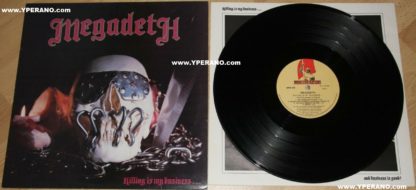




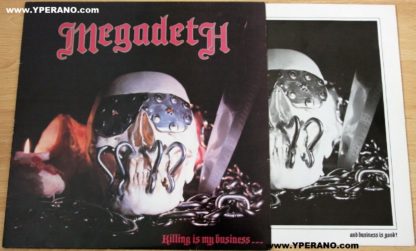








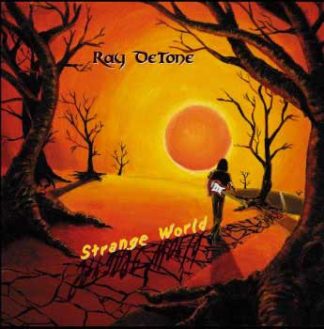
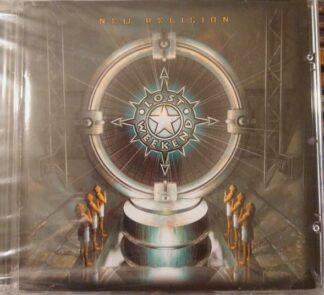
![DE/TEST: Language Of Violence CD [Neo Thrash Metal and Hardcore] a la MACHINE HEAD -](https://yperano.com/wp-content/uploads/2016/03/18279-DETEST-Language-Of-Violence-CD-Neo-Thrash-Metal-and-Hardcore-a-la-MACHINE-HEAD.jpg)



Reviews
There are no reviews yet.